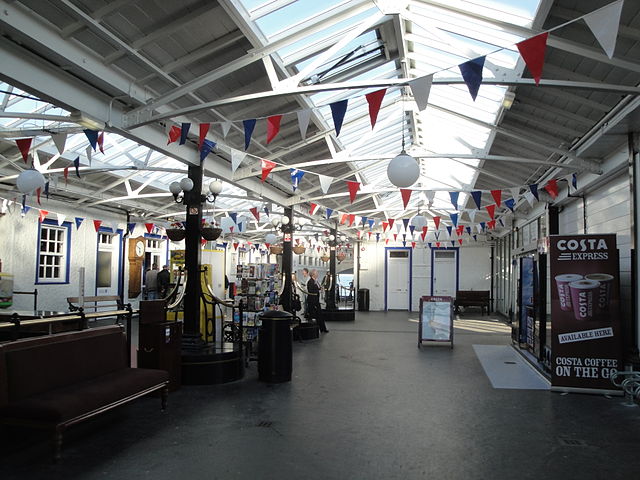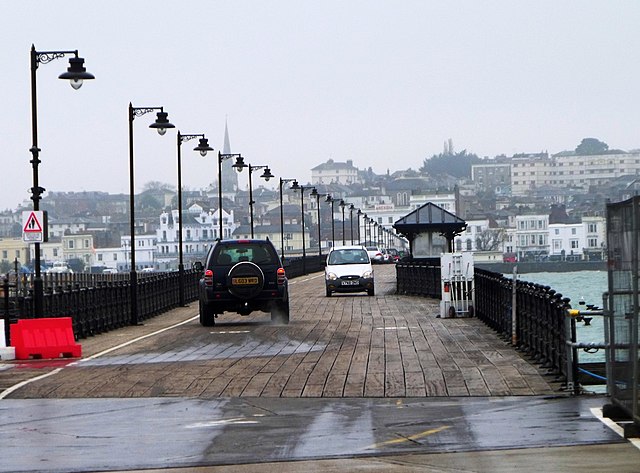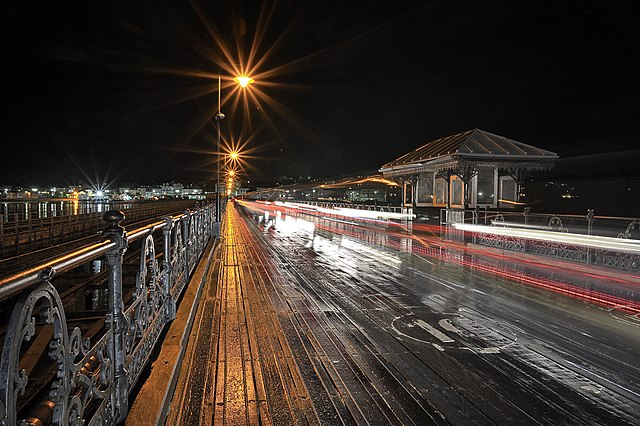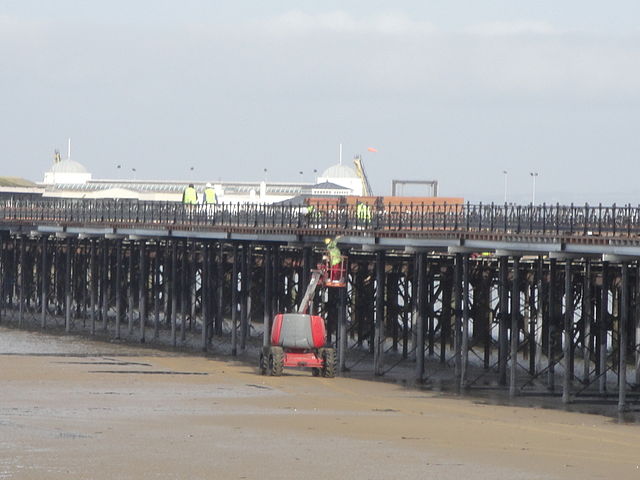
Photo by Wikimedia Commons – Wikimedia
Top 10 Remarkable Facts about Ryde Pier
It is an early 19th-century pier that serves the town of Ryde, on the isle of Wight. It is off the south coast of England and serves the town of Ryde. It is the world’s oldest seaside pleasure pier.
Ryde Pier head railway station is at the sea end of the pier and Ryder Esplanade railway station is at the land end, both served by Island line trains.
In 2005, Ryde Pier is featured briefly in the film Fragile, in an inaccurate scene where Calista Flockhart is driven along the Pier after leaving a Red Funnel car ferry.
In reality, the pier is only served by Wightlink craft, with Red Funnel services based out of Cowes and East Cowes, 6 miles otherwise 10 kilometers to the northwest.
From August 2010 to March 2011, Ryde Pier was closed to vehicles to allow structural repairs underneath the promenade pier.
The pier remained open to pedestrians, who from October 2010 used temporary decking on the tramway pier.
Some Wightlink foot passengers were allowed to use Island Line train services along the pier free of charge. Work to extend the Pier Head to allow for additional car parking continued during this period.
1. Before The Ryder Pier
Passengers had the most uncomfortable experience of coming ashore on the back of a porter and then walking as far as half a mile across wet sand before reaching the town.
All of this depended on the state of the tide. The need for a pier was painfully obvious especially since the town attracted wealthy and fashionable visitors who began to prefer other seaside resorts.
2. Pier Originality
It was designed by John Kent of Southampton. Its foundation was laid on 29th June
1813. The pier was opened on 26th July 1814, it measured 576 yards and was originally wholly timber. Extensions took place in 1883 and the overall length was 745 yards.
3. Additions To The Pier

Photo by Wikimedia Commons – Wikimedia
On 29th August 1864, a second pier was introduced as the tramway. The tram was powered by electricity from a third rail until 1969 when it was changed to petrol-power.
The third pier was opened on 12th July 1880 alongside the first two. It provided a direct steam railway link to the pier head. In fact, Empress Eugene landed at the Ryde Pier from Sir John Burgoyne.
In 1895, a concert pavilion was constructed at the pier head, and over the next sixteen years, the wooden piles were replaced with cast iron.
As for the pier head, it was remodeled in the 1930s using concrete and during the second world war was used for military purposes after various modifications.
4. Great Fame

Photo by Wikimedia Commons – Wikimedia
The Ryde Pier was made a Grade II listed building in 1976. In the 1980s, it was a
modern waiting area, including some of the original buildings like the original Victorian waiting rooms at the pier head.
More modifications took place in 2009 eg the provision of a conservatory-style refreshment area.
5. The Pier Today

Photo by Wikimedia Commons – Wikimedia
People are allowed to walk along the pier but must contend with motor traffic driving along the same wooden road. From August 2010 to March 2011, the pier was closed to vehicles to allow structural repairs underneath the promenade pier.
The pier remained open to pedestrians, some Wightlink foot passengers were allowed to use Island Line train services along the pier free of charge. On the weekend of 26th July 2014, the pier celebrated its 200th anniversary.
6. Other Piers

Photo by Wikimedia Commons – Wikimedia
For several decades, the Ryde had a second pier, the Victoria, which was a few
hundred yards to the east.
It was opened in 1864 as the main pier was getting its tramway. However, by 1900 the use of the bathing facilities was declining and the second pier slowly became derelict.
After the First World War led to it being considered redundant and a hazard. By the time the 1920s came around, the pier was already gone.
7. The Pier Hotel

Photo by Wikimedia Commons – Wikimedia
The Royal Pier Hotel was built soon after the original pier. It was to serve its increasing trade and traffic. It was on Pier Street opposite the bottom of Union Street for a hundred years.
However, The Pier Hotel was found to be a hazard to drivers, and instead of being repaired its demolition was ordered.
The Pier Hotel and the entire range of buildings back to the end of St Thomas street had been removed and Pier street itself ceased to exist becoming part of the Esplanade.
8. Concert Pavilion
There is a Concert Pavilion at the center of the narrative in Philip Norman’s book, Babycham Night.
The author’s family ran the concert pavilion when it was known as the Seagull Ballroom in the 1950s. His relatives produced the eponymous champagne perry.
The pavilion was later demolished, but a few of the rotting piles are still visible around the edge of an extended car parking area constructed in 2010.
9. Grade II Listed Building in 1976
It was made Grade II listed building in 1976 whereby a modern waiting area was constructed. This included some of the original buildings which replaced the Victorian waiting rooms placed at the pier head.
That notwithstanding, major modifications were made in 2009. Also the provision of a conservatory-style refreshment area with views towards Ryde.
In May 2011 the lighting columns on the Promenade Pier were fitted with Victorian-style brackets and lanterns.
9. Closed at some time for Repairs
From August 2010 to March 2011, Ryde Pier was closed to vehicles to allow structural repairs underneath the promenade pier, which had failed a regular inspection by Trant.
The pier remained open to pedestrians, who from October 2010 used temporary decking on the tramway pier. Some Wightlink foot passengers were allowed to use Island Line train services along the pier free of charge.
Work to extend the Pier Head to allow for additional car parking continued during this period. The promenade pier was then re-opened.
10. Cause of Demolitions
By 1900, the use of the bathing facilities was declining, and the second pier gradually became derelict.
The austerity of the First World War led to it being considered redundant and a hazard, and in 1916, its demolition was authorized by an Act of Parliament.
By the 1920s it had gone. Until the construction of the marina in the 1980s, the outline of the shore-end abutment could be made out in the sea wall near Ryde Pavilion, and at low spring tide, the stumps of the piles could be seen in the sand offshore.
Planning a trip to Paris ? Get ready !
These are Amazon’s best-selling travel products that you may need for coming to Paris.
Bookstore
- The best travel book : Rick Steves – Paris 2023 – Learn more here
- Fodor’s Paris 2024 – Learn more here
Travel Gear
- Venture Pal Lightweight Backpack – Learn more here
- Samsonite Winfield 2 28″ Luggage – Learn more here
- Swig Savvy’s Stainless Steel Insulated Water Bottle – Learn more here
Check Amazon’s best-seller list for the most popular travel accessories. We sometimes read this list just to find out what new travel products people are buying.









